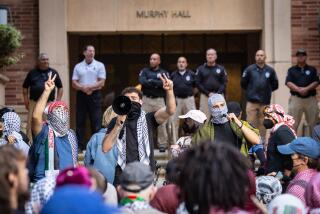Quality of Life Affects Safety
- Share via
For a generation, policing was seen only as after-the-fact response to criminal incidents, with little attention given to a community’s quality of life. Thanks to UCLA professor James Q. Wilson, the father of what is known as community policing, there has been a rethinking of how to make neighborhoods safe. And there is a newfound confidence that communities, in partnership with police, can reduce crime and make surroundings more livable.
Professor Wilson began this public rethinking with “Broken Windows,” his article asserting that quality of life helps determine community safety. Where there are broken windows and trash-strewn lots, there is an assumption that anything goes. Similarly, when relatively minor quality-of-life offenses are tolerated, the ground becomes fertile for serious crime. But where police enforce high community standards, a message is sent that the community cares and that lawlessness will not be tolerated.
This concept has been tested in a number of cities in California and throughout the country. Most striking has been the experience of New York, which reduced its major crime rate by 39% and murder by 49% over a four-year period. New York cops rid subways of turnstile jumpers and panhandlers, many of whom were graduating to more serious crimes, and they devised programs to involve the community in crime prevention, law enforcement and apprehension of criminals.
Recently, Assemblyman Bob Hertzberg (D-Sherman Oaks), the Public Safety Committee chairman, and I wrote to the Los Angeles Police Commission urging them to include experience in community policing and a dedication to it as criteria for Los Angeles’ new police chief. I’m pleased that commission standards now include this commitment to maximizing implementation of community policing.
With federal grants for added deputies, the Los Angeles County Sheriff’s Department is already engaged in high-impact community policing in problem areas. There deputies are relieved of shift work and calls for service over a 120-day period to give them time for training and intense community work. They personally survey residents, hold community meetings, follow up with focused crime suppression activities and mobilize and organize residents to take part in community revitalization. This accomplished, deputies resume normal responsibilities and relief personnel move on to the next problem area. Although funding has made this program possible, so too has citizen participation aided by trained peace officers.
To ensure that officers statewide learn the skills necessary to facilitate positive interaction in the community, I sponsored Assembly Bill 531. This measure, passed by the Assembly on Thursday, provides funds to the State Commission on Peace Officer Standards and Training (POST) to coordinate training programs, ensure that they meet POST standards and to identify successful programs for emulation.
Boston presents such a model. There, Harvard University’s John F. Kennedy School of Government initiated a research program to assist the city in identifying and interrupting youth gang and gun crimes. The school broke out of the pure research mode and weighed in by coordinating community meetings and multi-agency efforts to help win the war against gangs and violence.
*
This model can certainly be integrated in community policing in California, where we are fortunate to have a widespread university system and nationally renowned resources. That is why I am encouraging an expanded cooperative relationship between university campuses and local police departments to research and analyze community crime. It is also why I included in AB 531 an appropriation to the state Office of Criminal Justice Planning to provide research and coordination funds to aid in setting up community policing programs.
*
Other measures that came before the state Legislature this session also recognize the importance of community-oriented policing: Assembly Bill 853, sponsored by Hertzberg and passed by the Assembly on Thursday, appropriates $10 million to the city of Los Angeles for expansion of a multi-agency gang intervention program. Assembly Bill 1420, sponsored by Assemblyman Kevin Shelley (D-San Francisco) and also just passed by the Assembly, requires the state Office of Criminal Justice Planning to establish pilot programs in Los Angeles and San Francisco, with district attorneys assigned to work directly with neighborhood crime control efforts to shut down drug houses, reduce truancy and ensure safety for children traveling to and from school. Assembly Bill 367, sponsored by Assemblywoman Sally Havice (D-Cerritos) and passed Wednesday, calls for pooling resources from law enforcement agencies and the state and local school districts to implement a community-policing approach to school safety. (These measures now go to the state Senate.)
Community policing recognizes that it takes the efforts and resources of more than just police departments to make a community safe. It takes district attorneys, schools, probation departments, businesses, community organizations, social services and mental health departments and recreation programs. Most important, it takes the people who live and work in our communities to “fix the broken windows,” to set a standard of civility and lawfulness and to make our communities safer. It takes me. It takes you.
More to Read
Sign up for Essential California
The most important California stories and recommendations in your inbox every morning.
You may occasionally receive promotional content from the Los Angeles Times.










